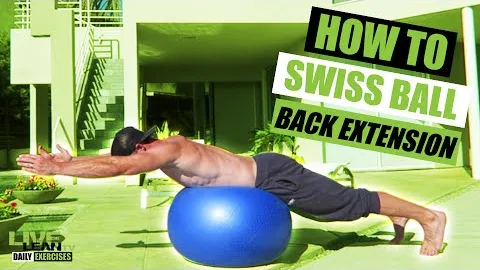
Swiss Ball Back Extension Rear Leg Raise: A Comprehensive Exercise Guide
The Swiss Ball Back Extension Rear Leg Raise is a dynamic exercise that targets multiple muscle groups, including the lower back, glutes, and hamstrings. This exercise is suitable for individuals of all fitness levels and can be performed at home or in a gym setting. In this guide, we will provide step-by-step instructions on how to perform the Swiss Ball Back Extension Rear Leg Raise correctly, the muscles it targets, and the benefits it offers. Let's dive in!
Equipment: To perform this exercise, you will need a sturdy Swiss ball and a clear space to work out.
Starting Position: Start by kneeling in front of the Swiss ball with your chest resting on the ball and your hips square. Place your hands behind your head or cross them over your chest.
Back Extension: Engage your core and lower back muscles as you lift your upper body off the ball, extending your spine until your body forms a straight line from head to toe.
Rear Leg Raise: Maintaining the back extension position, slowly raise one leg, keeping it straight and in line with your body. Lift until your leg is parallel to the ground or until you feel a contraction in your glutes and hamstrings.
Hold and Lower: Hold the raised leg for a brief moment, focusing on squeezing the glutes, before slowly lowering it back to the starting position. Repeat the movement with the opposite leg.
Repetitions: Aim for 10-12 repetitions on each leg for one set. If you are a beginner, start with fewer repetitions and gradually increase as you build strength and stability.
Sets: Complete 2-3 sets of Swiss Ball Back Extension Rear Leg Raise, resting for 30-60 seconds between sets.
The Swiss Ball Back Extension Rear Leg Raise primarily targets the following muscles:
Lower Back: As you extend your spine during the back extension phase, the muscles in your lower back (erector spinae) are engaged and activated.
Glutes: The gluteus maximus, the largest muscle in your buttocks, is the primary muscle worked during the rear leg raise. This exercise helps in toning and strengthening the glute muscles.
Hamstrings: The hamstring muscles, located in the back of your thighs, are also engaged as you raise your leg. This exercise provides a great opportunity to work on hamstring strength and stability.
Incorporating the Swiss Ball Back Extension Rear Leg Raise into your workout routine offers several benefits, including:
Core Stability: The Swiss ball adds an element of instability, challenging your core muscles to work harder to maintain balance throughout the exercise. This exercise improves core stability and helps prevent injuries related to weak core muscles.
Lower Back Strength: The back extension phase of this exercise targets the muscles in your lower back. By routinely performing the Swiss Ball Back Extension Rear Leg Raise, you can enhance lower back strength and reduce the risk of lower back pain or injuries.
Glute Activation: This exercise specifically targets the gluteus maximus, helping to activate and strengthen the glute muscles. Strong glutes are essential for functional movements and overall lower body strength.
Hamstring Strengthening: The rear leg raise movement engages the hamstring muscles, contributing to improved hamstring strength and flexibility. Strong hamstrings play a crucial role in enhancing athletic performance and maintaining lower body balance.
Posture Improvement: By strengthening the muscles in your lower back and core, this exercise promotes better posture. It helps correct imbalances and can alleviate back pain caused by poor posture.
When performing the Swiss Ball Back Extension Rear Leg Raise, it's essential to keep the following safety considerations in mind:
Form and Technique: Focus on maintaining proper form throughout the exercise. Engage your core, keep your spine neutral, and avoid excessive arching or rounding of the back.
Stability: Ensure that the Swiss ball is stable and properly inflated. Use a ball that suits your height and weight to prevent accidents or injuries.
Progression: If you are a beginner, start with simpler exercises that target the same muscle groups before advancing to the Swiss Ball Back Extension Rear Leg Raise. It's important to gradually increase intensity to avoid muscle strains or sprains.
Listen to Your Body: Pay attention to any discomfort or pain during the exercise. If you experience sharp pain or feel unstable, stop and consult with a fitness professional or healthcare provider.
The Swiss Ball Back Extension Rear Leg Raise is a versatile exercise that provides numerous benefits for your lower back, glutes, and hamstrings. By incorporating this exercise into your workout routine, you can enhance core stability, strengthen your lower back, activate your glutes, and improve hamstring strength. Remember to prioritize safety by maintaining proper form and gradually increasing intensity. So, grab a Swiss ball, follow the instructions, and enjoy the benefits of this effective exercise in your fitness journey!
If you're looking for a gym, fitness club or yoga studio, you've come to the right place.
You can find information about gyms in your area. Browse catalog of gyms and find gyms with classes which are you looking for.
On gym page you can find simple information like address, phone or website. You can find list of available classes. You can check availability of personal training or small group classes. On place page you can also see information about open hours.
You can find gyms near you with amenities, courts, studios and equipments.
Use our map to find gym at your city or district.
In Gym Navigator you can find list of exercises with movies for many body parts.
You can browse exercises catalog and find exercises the best of you.
You can also find exercises grouped into workout plans, which you can use to improve you body. Each routine show you exercises one by one and give you possibility to count you progress and count down rest time.